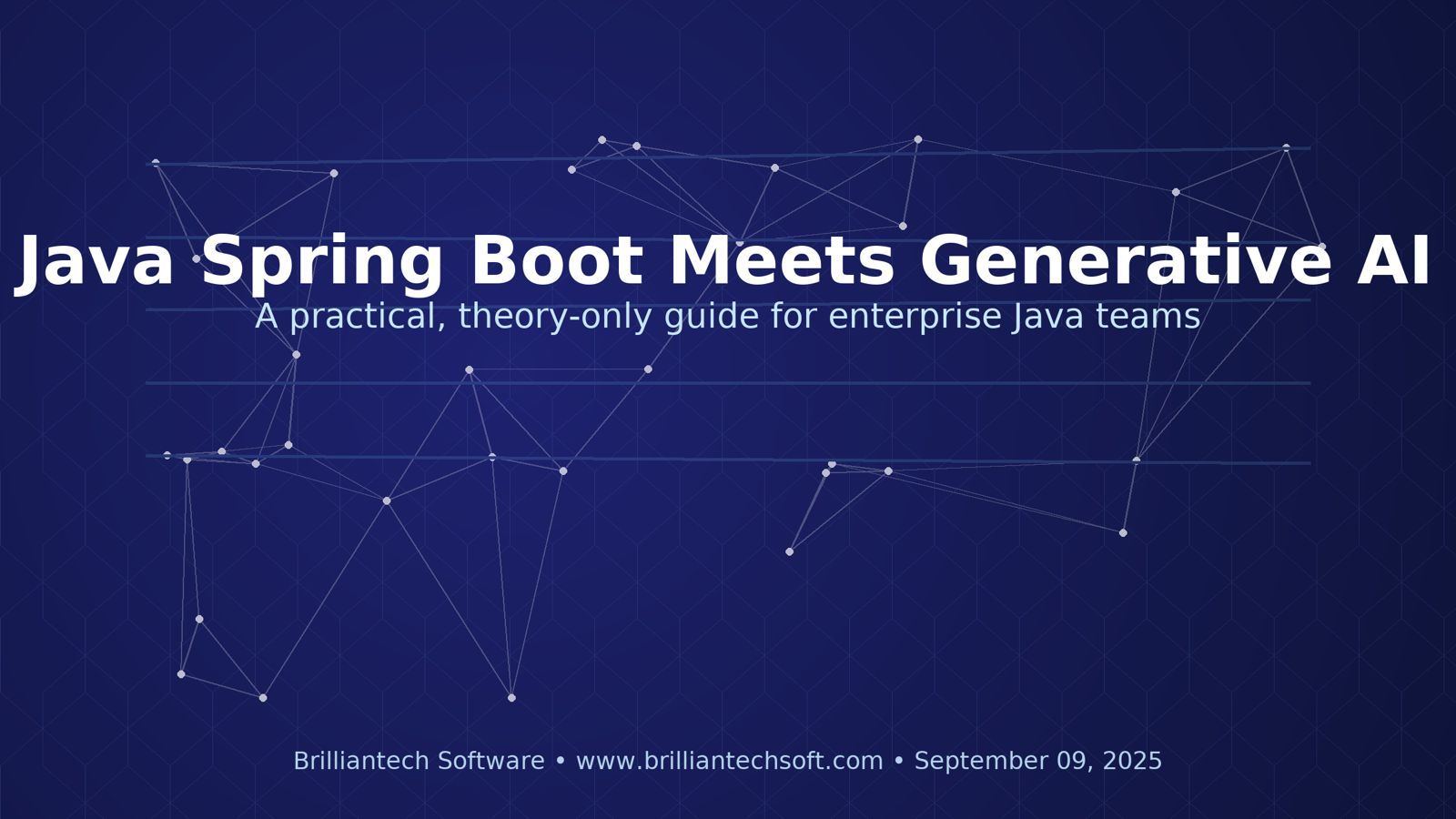Introduction
Generative AI (GenAI) is moving from novelty to necessity in enterprise Java. Teams want intelligent assistants for customer support, smarter search across private data, automated knowledge retrieval, and developer productivity boosts. If your stack is Spring Boot, Spring AI gives you a consistent, cloud-agnostic way to add LLMs, embeddings, Retrieval-Augmented Generation (RAG), and agentic capabilities—without tangling your codebase in provider-specific SDKs.
What is Spring AI?
Spring AI is an official Spring project that provides unified abstractions for chat/LLM models, embeddings, images, tool calling, vector stores, and observability. Think “Spring Data for AI”: a single programming model on top of multiple model providers (OpenAI, Vertex AI, and more), so you focus on features, not glue code. It includes a ChatClient API, prompt template facilities, vector store integrations, and first-class metrics/tracing. For enterprise Java, that means you integrate GenAI into existing Spring services, reuse Boot auto-config, and deploy on your standard platform while keeping options open across AI vendors.
Getting Started with Spring AI
At a high level you will: (1) pick a model provider, (2) configure the ChatClient and optional advisors (for logging, safety, etc.), and (3) define prompts and—if needed—tools and vector stores. Spring AI ships official integrations for providers like Google Vertex AI Gemini, so running on GCP is straightforward.
Spring AI vs. raw integrations: rolling your own usually means juggling multiple REST/SDKs, auth flows, schemas, rate limits, and bespoke observability. Spring AI centralizes those concerns behind consistent interfaces, reducing boilerplate and enabling cross-provider portability.
Core Concepts (Client Abstraction, Prompt Templates, Observability)
• Client Abstraction: ChatClient is the main entry point for sending prompts/messages to LLMs and composing advisor chains. It standardizes inputs/outputs across providers and integrates with Spring Boot configuration.
• Prompt Templates: Prompts are first-class. You can create reusable templates with variables and structure them as system/user messages for predictable behavior—critical for enterprise scenarios where prompts become part of application logic.
• Observability: Spring AI builds on Micrometer/Spring Observability to emit metrics and traces for ChatClient, ChatModel, EmbeddingModel, ImageModel, and VectorStore. Low-cardinality keys go to metrics; high-cardinality data is reserved for traces—so you get signal without cardinality explosions. This is essential for SLOs, cost tracking, and auditing.
Advanced Patterns (Workflows vs Agentic Patterns)
Spring frames two useful archetypes:
• Workflows: deterministic, predefined orchestration where your code drives each tool step (great for compliance and repeatability).
• Agents: the model steers the process and decides when to call tools, enabling more adaptive behavior.
Spring AI supports Tool Calling so models can request capabilities (DB lookups, calculations, API calls) that your app exposes, with a clean, declarative programming model—key to agentic use cases in the enterprise.
Retrieval-Augmented Generation (RAG)
RAG grounds model outputs in your private data. With Spring AI you can create embeddings for documents, store vectors in supported VectorStores (e.g., pgvector for Postgres), and use a retriever to fetch semantically similar snippets and feed them to the model for accurate, auditable responses. Operational note: some stores require explicit schema initialization—don’t skip this in production.
Model Context Protocol (MCP)
MCP is an emerging standard for connecting models to tools, data, and context via a common protocol—reducing custom adapters and improving portability. The Java/Spring ecosystem is exploring MCP patterns, including building MCP servers and clients with Spring Boot/Spring AI. Expect MCP to accelerate safe, audited tool access across teams and vendors.
Cloud Integration Opportunities
If you’re on Google Cloud, Spring AI pairs naturally with Vertex AI (Gemini for text/multimodal, Embeddings, Model Garden) and Cloud Run for serverless deployment. Google Cloud’s guidance highlights Spring AI 1.0 as a path to bring AI into existing Spring applications with minimal friction, plus enterprise guardrails and managed services. Community examples also showcase Spring Boot + Spring AI + Gemini patterns—useful when you want to keep the app in Java while offloading model serving and monitoring to Vertex AI.
Best Practices (for real-world teams)
• Prompt engineering as design: treat prompts like code—version them, template them, and test them. Use advisors/logging to capture inputs/outputs for QA and governance.
• Observability & cost controls: emit metrics/traces for latency, token counts, and tool calls; wire dashboards and alerts before you scale traffic.
• RAG for grounding: prefer retrieval over giant system prompts. Keep chunks, metadata, and filters tuned to your domain; verify schema/init for vector stores.
• Ethical & safe use: log decisions, constrain tools, and design human-in-the-loop for sensitive actions. (Agentic ≠ autonomous.)
• Plan for multimodality: architect for embeddings and images (e.g., receipts, diagrams) since Spring AI already models these concepts.
Forward-Looking: What’s Next
• MCP adoption will standardize how apps expose tools and data to models, improving interoperability across vendors and IDEs.
• Agentic + workflow hybrids will become the norm: deterministic guards around adaptive reasoning, all observable and testable.
• Cloud-native AI will keep maturing: managed vector DBs, model gateways, and enterprise policy controls paired with Spring Boot’s deployment story.
Conclusion & Key Takeaways
• Spring AI gives Spring Boot teams a clean, portable path to GenAI—abstractions for prompts, models, tools, embeddings, and observability.
• Start with a small POC: one use case (e.g., knowledge assistant with RAG), one model provider, production-grade logging/metrics, and a clear success metric.
• As you scale, harden observability, governance, and tool boundaries; consider MCP for future-proof integration and Vertex AI for managed enterprise services.
References
Spring AI – Chat Client API
Spring AI – Prompt Templates
Spring AI – Observability
Spring AI – Vector Databases
Spring AI – Retrieval-Augmented Generation
Spring AI – PGVector
Spring AI – Tool Calling
Spring Blog – Agentic Patterns (Workflows vs Agents)
Foojay – Spring AI & RAG in Java
JavaTechOnline – Spring AI Concepts
Google Cloud Blog – Spring AI 1.0 & GCP
Medium (Google Cloud) – Gemini with Spring AI
JAX London – MCP with Spring Boot
Brilliantech Software builds modern, secure, and scalable digital solutions for enterprises. This article was prepared by the Brilliantech engineering team to help Java architects and developers evaluate Spring AI for real-world use cases. Learn more at https://www.brilliantechsoft.com/.
